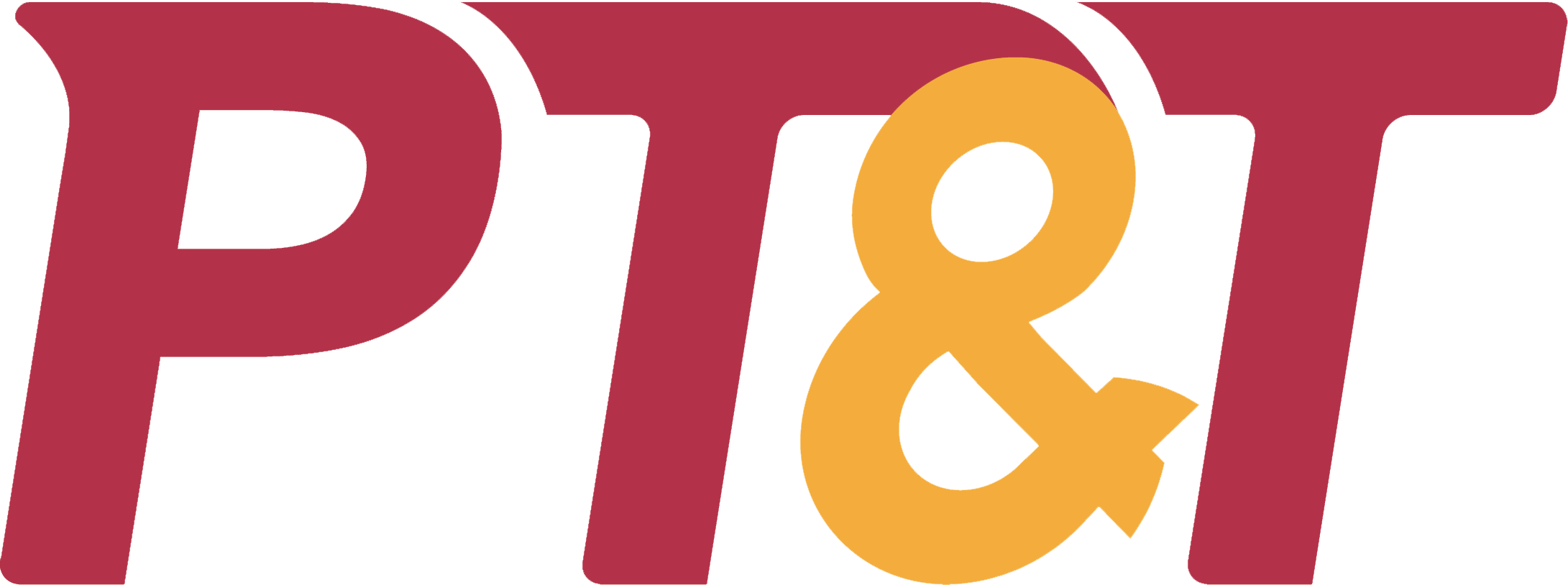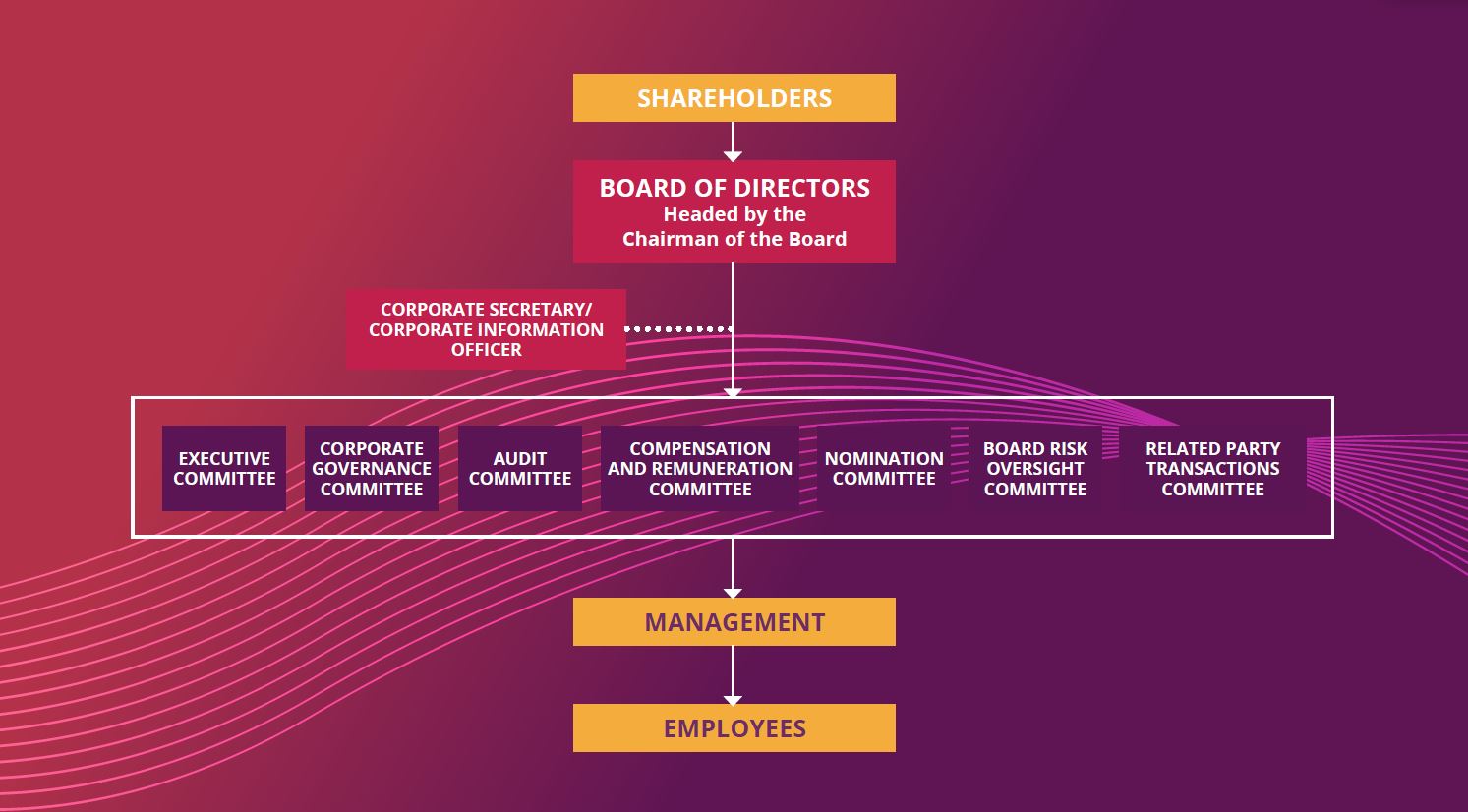Governance Structure
PT&T is strongly committed in observing the highest standards of corporate governance in order to serve the best interests of all our stakeholders. The Board of Directors, Management, employees, and shareholders of PT&T believes that effective corporate governance is a necessary component of what constitutes sound strategic business management and will, therefore, continuously undertake every effort necessary to create awareness of good corporate governance within the company and to sustain increased value for its shareholders.
Maintaining this strong foundation of good governance becomes more essential as a guide to PT&T’s attainment of its corporate goals as it grows both in its existing space and in the new markets it enters. PT&T hereby declares its continuing commitment to its Vision, Mission, and Corporate Values.
PT&T institutionalized the principles of good corporate governance practices and these can be found in our Articles of Incorporation and By-laws. PT&T is in full compliance with the code of corporate governance and all listing rules of the Philippine Stock Exchange (PSE) and regulations adopted by the Securities and Exchange Commission (SEC).
Governance Structure
Board of Directors
Compliance with the principles of good corporate governance shall start with the Board of Directors of PT&T where the company’s management is centralized.
The Board of Directors is primarily responsible for the governance of the company. It shall provide an independent check on Management on adherence to the policies set for the accomplishment of the corporate objective.
It shall be the Board’s responsibility to foster the long-term success of PT&T and secure its sustained competitiveness in a manner consistent with its fiduciary responsibility, which it shall exercise in the best interest of PT&T, its shareholders and other stakeholders. The Board shall conduct itself with utmost honesty and integrity in the discharge of its duties, functions, and responsibilities.
Board Committees
The Board of Directors may create such committees as it may deem necessary to support it in the performance of its functions and in accordance with the By-Laws of the company and to aid in good governance. The Board may delegate part of its rights and responsibilities to any of its committees. The committees shall be composed of Board members specifically chosen for their particular background and areas of expertise that will allow them to adequately perform the functions assigned to their committee. Membership of the committees shall be reviewed annually, subject to the approval of the Board.
The Board of Directors is supported by seven (7) committees, namely, the (i) Executive Committee, (ii) Nomination Committee, (iii) Audit Committee, (iv) Compensation and Remuneration Committee, (v) Board Risk Oversight Committee, (vi) Related Party Transactions Committee, and (vii) Corporate Governance Committee. These committees are required to report to the Board a summary of the actions taken on matters submitted to them for consideration. Each Board Committee shall have and be guided by its own charter, to be approved by the Board, and shall be supported by the Office of the Corporate Secretary in the performance of its functions.
The Board may establish such other committees as may be deemed necessary for the efficient and effective performance of its functions.
Corporate Secretary
The Board is assisted in its duties by a Corporate Secretary, who is a separate individual from the Compliance Officer of the company.
The Corporate Secretary ensures that the Board and the Management follow internal and external rules and regulations. He facilitates clear communications and work fairly and objectively with the Board, Management, stockholders and other stakeholders. He also serves as an adviser to the Directors on their responsibilities and obligations.
The Corporate Secretary shall have such other responsibilities as the Board of Directors may impose upon him. The Board shall have separate and independent access to the Corporate Secretary.
Compliance Officer
To ensure adherence to corporate principles and best practices, the Board appoints a Compliance Officer who reports directly to the Chairman of the Board.
The Compliance Officer monitors compliance by the company with the Corporate Governance Manual and the rules and regulation of the regulator agencies and, if any violations are found, report the matter to the Board and recommend the imposition of appropriate disciplinary action on the responsible parties and the adoption of measures to prevent a repetition of the violation.
The Compliance Officer performs such other duties and responsibilities as may be provided by the SEC.
Corporate Governance Office
The Corporate Governance Group is the unit tasked to formulate and implement the initiatives and policies on good corporate governance. It has been active in the continuous conduct of orientation to all PT&T employees and business partners on the company’s governance policies, particularly on matters contained in the Manual and the Code of Business Conduct and Ethics.
Among the mandates of the unit is the continuous identification of gaps and challenges on corporate governance practices across the organization. This allows the unit to propose improvements on the company’s policies based on international corporate governance standards. The unit also provides timely updates to the Board and the Management on the current and best practices on corporate governance in the industry and globally.
Internal Audit
The Internal Audit Group provides independent and objective assurance and advisory services to the company designed to add value and improve on its operations. It shall perform its auditing functions faithfully by maintaining independence from the Management and controlling shareholders.
The Internal Audit Group provides the Board, Management, stockholders, and other stakeholders an effective system of internal control that will ensure the integrity of the financial reports and protection of the assets of the company for the benefit of all. It provides a reasonable assurance that the company’s key organizational and procedural controls are effective, appropriate, and complied with. It also monitors and evaluates the company’s governance processes.
Management
Management stands as the locus of decision-making for the day-to-day affairs of the company. It determines the company’s activities by putting the company’s targets in concrete terms and by formulating the basic strategies for achieving these targets. It also puts in place the infrastructure for the company’s success by establishing the following mechanisms in its organization:
- Purposeful legal and organizational structures that work effectively and efficiently in attaining the goals of the company;
- Useful planning, control, and risk management systems that assess risks on an integrated cross-functional approach;
- Information systems that are defined and aligned with IT strategy and the business goals of the company;
- Plan of succession that formalizes the process of identifying, training, and selection of successors in key positions in the company.
Management is primarily accountable to the Board for the operations of the company. As part of its accountability, it is also obligated to provide the Board with complete, adequate information on the operations and affairs of the company in a timely manner.
External Auditor
The Board, through the Audit Committee, recommends to the stockholders a duly accredited external auditor who shall undertake an independent audit and shall provide an objective assurance on the way in which the financial statements shall have been prepared and presented.
The External Auditor perform fair audits independently from the company, its management and controlling shareholders, so that shareholders and other users may maintain confidence in the Corporation’s accounting information. He checks whether any fact conflicts with the audit results in the information disclosed regularly with the audited financial statements, and demand correction, if necessary. He also perform such other functions as may be approved by the Board in its engagement of the auditor provided, however, that non-audit work shall not be in conflict with the functions of the auditor as external auditor.
If an external auditor believes that the statements made in an annual report, information statement, or proxy statement filed during his engagement is incorrect or incomplete, he shall also present his views in said reports.
Investor Relations
The Investor Relations (IR) team is tasked to regularly keep the company’s investors, stockholders, and stakeholders informed of the developments in the company’s business. For this purpose, the IR conducts quarterly analysts’ briefings and regular meetings with shareholders, fund managers, and analysts to keep them updated on the financial and operating performance of the company as well as other relevant material information and details on transactions of the company.
The IR is easily reached through the contact details provided herein or in the company website for any stockholder, stakeholder, or investor concerns.
Company Website
In the pursuit of the PT&T’s drive to continuously improve awareness of best practices in the conduct of its business and operations especially in corporate governance across the organization, including dealings with its business partners and customers, the company constantly updates its website, www.ptt.com.ph, with a section dedicated to corporate governance and investor relations.
The Corporate Governance section of the website contains all disclosures made by PT&T to the PSE and SEC, as well as its Manual, the Code, the Charters of the Board and its Committees, the Policies and other matters and information of relevance to all stakeholders. PT&T discloses its corporate governance practices, corporate events calendar, and other material information on its website in a timely manner.
The Investor Relations section houses all information that may be required by the investors, shareholders, and stakeholders.
The site has been enhanced to be user-friendly and is always accessible to the public.

